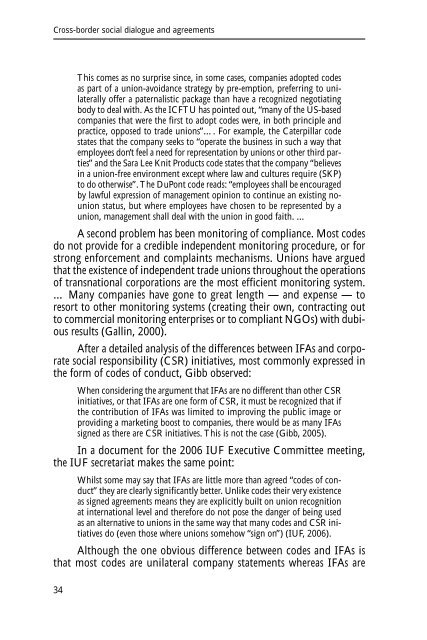CROSS-BORDER SOCIAL DIALOGUE AND AGREEMENTS: An ...
CROSS-BORDER SOCIAL DIALOGUE AND AGREEMENTS: An ...
CROSS-BORDER SOCIAL DIALOGUE AND AGREEMENTS: An ...
You also want an ePaper? Increase the reach of your titles
YUMPU automatically turns print PDFs into web optimized ePapers that Google loves.
Cross-border social dialogue and agreements<br />
This comes as no surprise since, in some cases, companies adopted codes<br />
as part of a union-avoidance strategy by pre-emption, preferring to unilaterally<br />
offer a paternalistic package than have a recognized negotiating<br />
body to deal with. As the ICFTU has pointed out, “many of the US-based<br />
companies that were the first to adopt codes were, in both principle and<br />
practice, opposed to trade unions”…. For example, the Caterpillar code<br />
states that the company seeks to “operate the business in such a way that<br />
employees don’t feel a need for representation by unions or other third parties”<br />
and the Sara Lee Knit Products code states that the company “believes<br />
in a union-free environment except where law and cultures require (SKP)<br />
to do otherwise”. The DuPont code reads: “employees shall be encouraged<br />
by lawful expression of management opinion to continue an existing nounion<br />
status, but where employees have chosen to be represented by a<br />
union, management shall deal with the union in good faith. …<br />
A second problem has been monitoring of compliance. Most codes<br />
do not provide for a credible independent monitoring procedure, or for<br />
strong enforcement and complaints mechanisms. Unions have argued<br />
that the existence of independent trade unions throughout the operations<br />
of transnational corporations are the most efficient monitoring system.<br />
… Many companies have gone to great length — and expense — to<br />
resort to other monitoring systems (creating their own, contracting out<br />
to commercial monitoring enterprises or to compliant NGOs) with dubious<br />
results (Gallin, 2000).<br />
After a detailed analysis of the differences between IFAs and corporate<br />
social responsibility (CSR) initiatives, most commonly expressed in<br />
the form of codes of conduct, Gibb observed:<br />
When considering the argument that IFAs are no different than other CSR<br />
initiatives, or that IFAs are one form of CSR, it must be recognized that if<br />
the contribution of IFAs was limited to improving the public image or<br />
providing a marketing boost to companies, there would be as many IFAs<br />
signed as there are CSR initiatives. This is not the case (Gibb, 2005).<br />
In a document for the 2006 IUF Executive Committee meeting,<br />
the IUF secretariat makes the same point:<br />
Whilst some may say that IFAs are little more than agreed “codes of conduct”<br />
they are clearly significantly better. Unlike codes their very existence<br />
as signed agreements means they are explicitly built on union recognition<br />
at international level and therefore do not pose the danger of being used<br />
as an alternative to unions in the same way that many codes and CSR initiatives<br />
do (even those where unions somehow “sign on”) (IUF, 2006).<br />
Although the one obvious difference between codes and IFAs is<br />
that most codes are unilateral company statements whereas IFAs are<br />
34
















